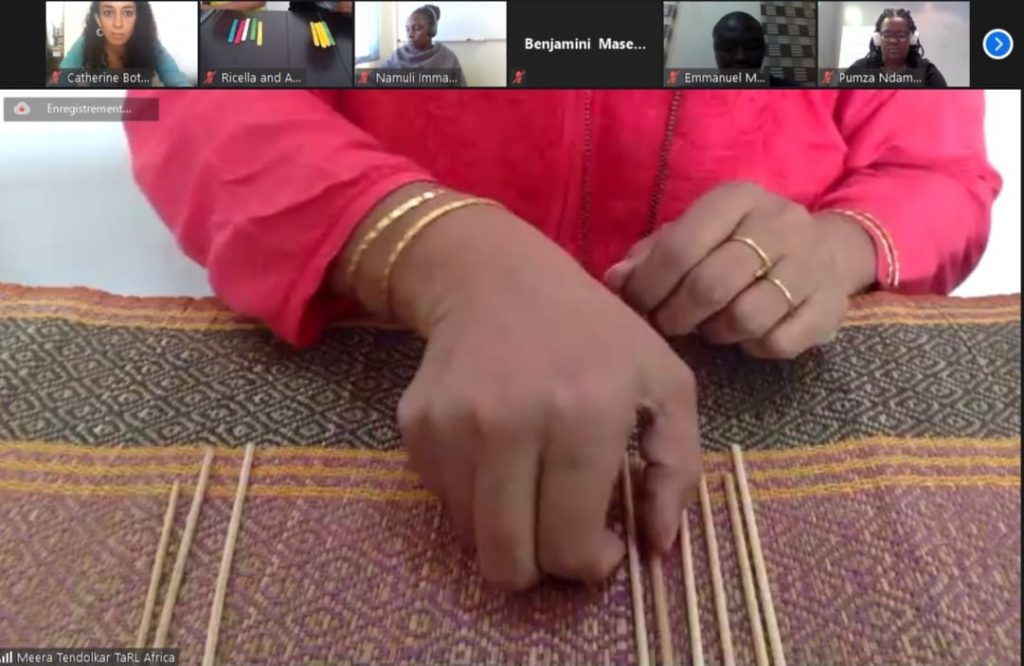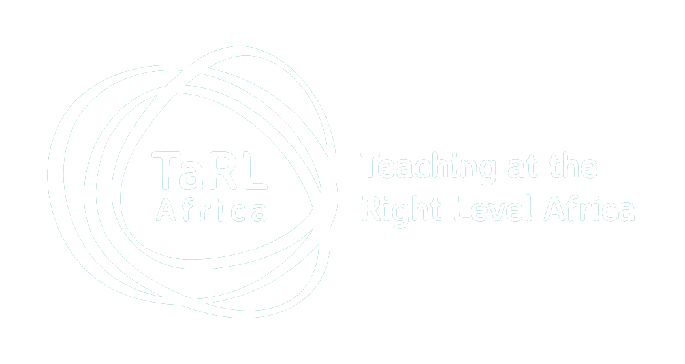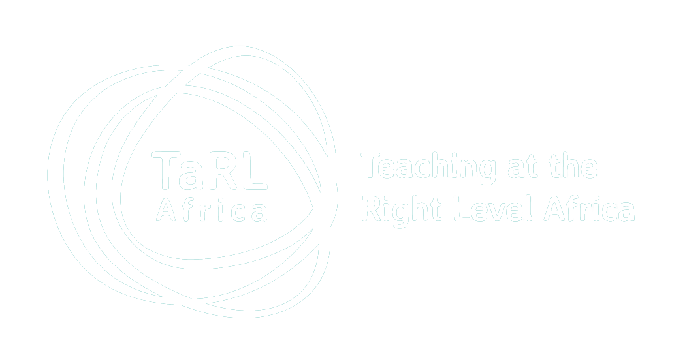
Team members from TaRL Africa conduct an energizer during a TaRL training. Photo: Teaching at the Right Level (TaRL) Africa.
With the onset of the COVID-19 pandemic, much of TaRL Africa’s work had to be shifted online. TaRL Africa central team members, Vikas Varma, Indresh Talsaniya, and Chavi Jain reflect on the team’s experiences of adapting face-to-face TaRL trainings to the virtual space in this blog documented by Tanvi Banerjee.
In March 2020, our plans came to a standstill. Initially, several members of the team were supposed to visit Egypt to deliver an in-person training on the Teaching at the Right Level (TaRL) Approach. We were in high spirits as this would be our first time conducting a TaRL training in Arabic (and visiting the pyramids). Some team members were also preparing to conduct field visits to other countries such as Zambia, where the Catch Up (TaRL) program is implemented. However, all of a sudden, all activities were halted due to the COVID-19 pandemic. Like the rest of the world, we too went into lockdown.
In the first few weeks, there was much uncertainty. No one was sure how to proceed with our fieldwork. However, we realized that the pandemic would not let us go back to the old “normal” any time soon and that we needed to prepare for extended lockdowns. Everyone started thinking about the consequences of the pandemic on children’s learning. Immediately, we started making plans to deliver TaRL trainings through different mediums. By April 2020, we had decided to conduct virtual trainings to provide our technical expertise and know-how to TaRL implementers.
Lessons From the First Virtual Training
Over the past year, we have conducted several trainings virtually. Each training has given us valuable insights into improving the delivery of TaRL trainings and an opportunity to learn how to adapt to diverse contexts. We began our journey with virtual trainings for a project in Egypt in May 2020. It remains one of the most memorable trainings for our team, and there is much we learnt from this experience.
The process of adapting our in-person training into a virtual one was not easy. Data indicates that formal in-person training leads to higher motivation levels, increased perceived value of the training, and knowledge retention. Additionally, TaRL training has a physical component. We play games and conduct several interactive activities. Therefore, we had several concerns on how to perform the training virtually, including the following:
How long should we spend in front of a computer or laptop?
Usually, a TaRL training is conducted over 5 to 7 days, and we devote at least 7-8 hours to delivering content every day. Sometimes, even after finishing a full day of training, we would have to set aside an hour or two for discussions with trainees regarding their doubts and questions. However, we also understood that replicating this kind of a training virtually would not be easy. For instance, we knew that an 8-hour long virtual training might not be very successful given technical challenges.
How should we train participants on TaRL activities, which often need live demonstrations?
The majority of TaRL training involves instructing participants on conducting level-based activities to teach foundational math and language to learners. We follow the ‘learning by doing’ approach, using live demonstrations for the activities and asking trainees to practice these with children from their schools or neighbourhoods.
Some of our other concerns before the virtual training included making sure that the participant received enough practice during training; ensuring that everyone received the same information; managing time differences; navigating technical issues; and effectively training individuals who might not be proficient in English.
After some thought, the team identified some solutions to these challenges:
- Increase the duration of the training: In our first virtual training, we increased the number of training days from 7 to 14. Given that this training was held in Egypt, we added extra days to ensure adequate time for translation and to account for any time lost due to technological challenges.
- Reduce the number of training hours per day: Since we were apprehensive about connectivity and concentration issues, we decided to reduce the virtual training hours to 4-5 hours per day with adequate breaks.
- Conduct live demonstrations or show recordings of the activities: The team initially had differing opinions on how to deliver the content. However, we decided to use live demonstrations and video recordings to show how to conduct activities. When using live demonstrations during the training, we ask participants to participate and follow along. However, certain activities cannot be demonstrated live. To cover these activities, we use videos that we created recently in addition to new videos created in the field.
- Make content engaging: It was hard to find a single method to teach the activities to the participants. We, therefore, began experimenting. For some activities, we showed participants a video with just our hands as we conducted the activity. Additionally, colleagues in the team started using animated PowerPoint presentations to demonstrate math activities.
- Leverage technology to ensure participants practice the approach: To increase comfort with the approach, we encouraged participants to practice the activities and TaRL processes. During virtual training, it can be difficult to conduct teach-backs and group practice sessions as trainees might join from different locations. Hence, we came up with an idea to ensure that participants kept practising. We now provide participants with homework and request them to record a video of themselves conducting practice classes with group members, children in their neighbourhoods and schools, or with members of their family. We then ask participants to share the activities with us through online messaging apps such as WhatsApp or upload the videos to a shared cloud folder.

Through post-training feedback, we learnt that participants found live demos to be more effective than pre-recorded videos.
- Create active channels for communication: From our experience, we learnt that it was important to ensure that participants continue to be engaged during the training and have an opportunity to clarify doubts. Therefore, we create WhatsApp Groups with trainers and all the participants. This channel can be used by participants to ask doubts, share material, coordinate with group members, and more. We have even started using platforms like Google Docs and Padlet as parking spaces for participants’ questions and other training-related materials.
However, one of the most persistent challenges that we have faced has been making sure that everyone can adapt to the technology used to conduct these trainings. For instance, we try to ensure that the participants have access to good internet for the duration of the training. Additionally, some participants recently started using zoom. To keep everyone aware of some technical rules, we added a housekeeping session to provide basic training rules.
Adapting to Feedback and Local Contexts
The team’s virtual training has been evolving through constructive feedback and tailoring the training to fit the local realities. For instance, after our first training in Egypt, we received feedback that we should work on reducing the number of days instead of having shorter sessions. In subsequent training, we thus started to revise timings based on partner organization’s availability.
We also started to plan for training in environments where participants could gather in one place while our team continued to operate digitally. In such a situation, we asked coordinators from the trainee organizations to work on the following arrangements:
- Ensure that the training venue has good internet connectivity
- Have a backup in place for the Internet
- Have a backup in place to address power cuts
- Have access to microphones and a speaker system
- Ensure access to training material
These context-specific adaptations have helped. Recently, we successfully trained an organization working with refugees in Uganda despite connectivity issues. For this training, we reduced the number of days from 14 to 8 days. Instead, we increased the session time from 5 hours to 8 hours with adequate breaks. Additionally, in this training, we tried to use live demonstrations and animated PowerPoint presentations more effectively. Through our experiences in different contexts, we have also learned an important lesson: No matter the changes made to the training, it is important to ensure that participants remain engaged for the entirety of the training.
New Opportunities
As the pandemic rages on, we have had to embrace the ‘new normal.’ Since our first virtual training in May 2020, we have come a long way. We have successfully completed 7+ trainings and have received positive responses for the way they were conducted. While the pandemic disrupted business as usual, it also provided us with an opportunity to build capacity and experiment with technology.
There are exciting prospects for how we can continue to utilize virtual training in a post-pandemic world—potentially using hybrid training to make programmes more cost-effective and to increase efficiency. We are excited to keep building on our experiences to make training on TaRL more resilient to externalities, adaptable and accessible.

A colleague from TaRL Africa demonstrates a math activity during a virtual training. Photo: Teaching at the Right Level (TaRL) Africa

